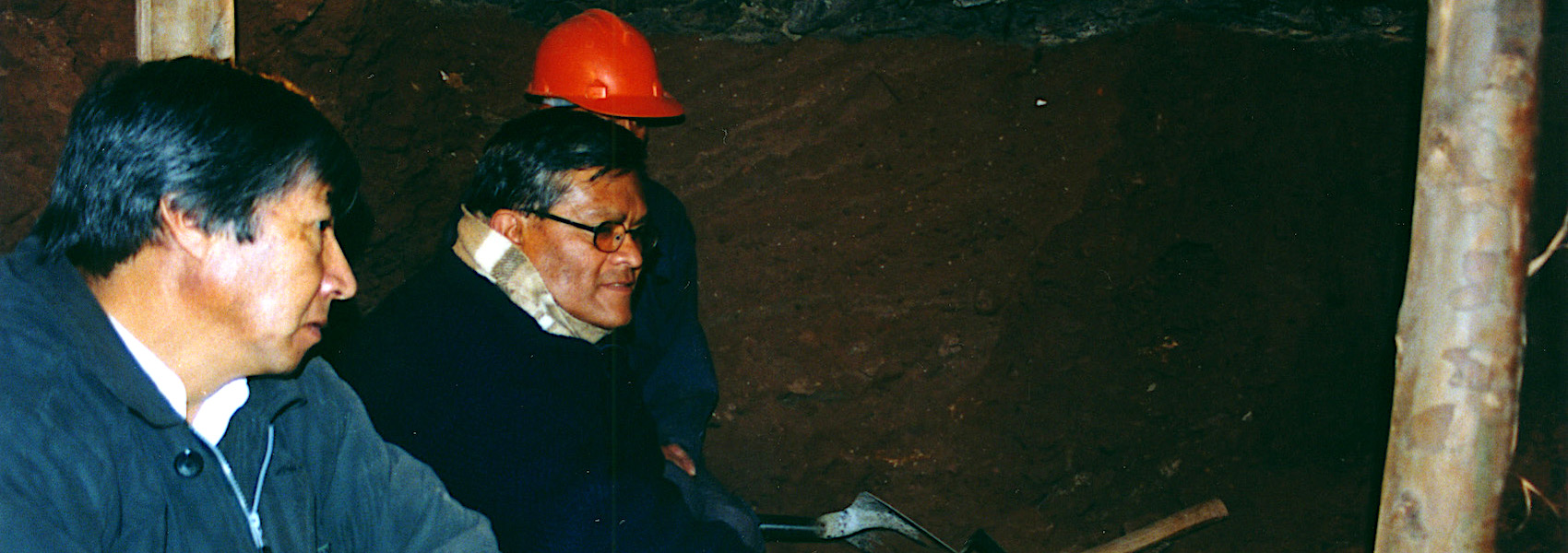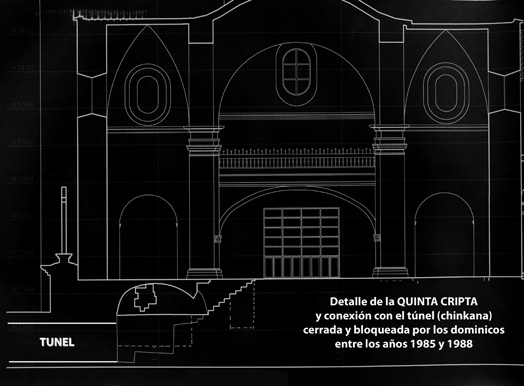In our first works, we used state-of-the-art remote sensing equipment with very satisfactory results.
We found archaeological remains in many places of the Convent, in the Museum, in the First Cloister,
in the Temple of the Stars, and especially in the area of the church where the Hall of the Sun had
been, the most important of the Koricancha and where the entrance to the famous Chinkana that connects
with the labyrinths of Saqsaywaman was located.
Inca walls were discovered, a colonial crypt from the 17th century in the area of the transept next to
the High Altar, the original bases of the Sun Hall (the most important of the Koricancha) and its exact
location (so sought after by many researchers for years like John Rowe) with the incredible surprise that
these bases are not Inca but pre-Inca built with green diorite (a fact that makes us reconstruct the
history of the Koricancha). But despite all these important findings, the ground-penetrating radar did
not find the entrance to the Chinkana where Anselm Pi Rambla, Frances Serrat, and the Prior of that time
entered in 1982. The hasty conclusion reached by the Dominicans and some authorities was that the tunnel
did not exist and that Anselm Pi Rambla was lying or mistaking the place where he saw the tunnel.
 From that moment on, things started to become complicated. The archaeologists from the National
Institute of Culture (INC) wanted to conduct an extensive excavation on both sides of the church based
on the indications found with the georadar, but the priests vehemently opposed it, violating the contract
signed between the parties from the beginning. They argued that every day at 5 PM, mass was celebrated
in the church and these extensive works would disturb the faithful. So, after this significant
inconvenience, we reached an agreement with Prior Hector Herrera to section off the excavation spaces
into very small areas. This slowed down the work and greatly increased the budgets established initially.
With this situation, Bohic Ruz decided to suspend the works for some time with the permission of the
INC to clarify the facts. We left open and consolidated some critical areas excavated because we
suspected that they had been altered by the Dominicans after the earthquake of 1950 and it was not
clear that the radar would not detect the tunnel entrances. We asked the priests to open a contiguous
area to this altered zone where the radar showed very significant anomalies, but from that moment on,
things changed radically. The Dominicans prohibited the continuation of the works because they did
not agree with our work proposals and agreed with the National Institute of Culture of Cusco to
definitively close them.
From that moment on, things started to become complicated. The archaeologists from the National
Institute of Culture (INC) wanted to conduct an extensive excavation on both sides of the church based
on the indications found with the georadar, but the priests vehemently opposed it, violating the contract
signed between the parties from the beginning. They argued that every day at 5 PM, mass was celebrated
in the church and these extensive works would disturb the faithful. So, after this significant
inconvenience, we reached an agreement with Prior Hector Herrera to section off the excavation spaces
into very small areas. This slowed down the work and greatly increased the budgets established initially.
With this situation, Bohic Ruz decided to suspend the works for some time with the permission of the
INC to clarify the facts. We left open and consolidated some critical areas excavated because we
suspected that they had been altered by the Dominicans after the earthquake of 1950 and it was not
clear that the radar would not detect the tunnel entrances. We asked the priests to open a contiguous
area to this altered zone where the radar showed very significant anomalies, but from that moment on,
things changed radically. The Dominicans prohibited the continuation of the works because they did
not agree with our work proposals and agreed with the National Institute of Culture of Cusco to
definitively close them.

Architect Ernesto Paz & Prior Hector Herrera inside the excavations
It seems that on August 19, 2003, an agreement was signed at the National Institute of Culture in Cusco, obliging Bohic Ruz Explorer to pay for the closure of works and leave the Koricancha permanently. A month later, the closure of works and the final closure of the project were handed over to the government of Peru. However, soon after, the Peruvian press (El Comercio, 23/8/2003) reported that the company had put the church's structures in danger, that Bohic Ruz Explorer were treasure hunters, and that the entire project had been a deception. Before concluding this report, we want to state for the first time that, despite the forced closure of the project, we continued to investigate all the reports obtained from the excavations and conducted a thorough review of all the data provided by the GEORADAR. As expected, thanks to the advanced technology and meticulous attention to detail in our investigations, we were able to pinpoint the exact location of the Crypt (FIFTH CRYPT) inside the church, where I personally entered with Francesc Serrat and the Prior of the Convent at that time in 1982. Therefore, we are pleased to inform the international community that the CHINKANA EXISTS AND IS REAL.
Furthermore, the author wants to detail that the Quinta Cripta was definitively closed by some Dominicans between 1985 and 1988, and it seems that the current community of fathers living in the Convent is unaware of these events and their authors. The author wants to emphasize that the Dominicans, by law, cannot touch archaeological structures in the Koricancha without the relevant permits from the government of Peru, even if these remains are on their property. Thus, the alteration and closure of this important area where the crypt and the entrance to the great Chinkana were located are illegal and sanctioned by Peruvian law.

